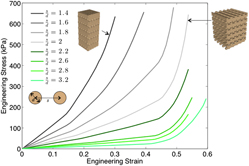Crossref Citations
This article has been cited by the following publications. This list is generated based on data provided by
Crossref.
Herzberger, Jana
Sirrine, Justin M.
Williams, Christopher B.
and
Long, Timothy E.
2019.
Polymer Design for 3D Printing Elastomers: Recent Advances in Structure, Properties, and Printing.
Progress in Polymer Science,
Vol. 97,
Issue. ,
p.
101144.
Zhu, Xiaowei
Chen, Yanqiu
Liu, Yu
Tang, Changyu
Liu, Tong
Mei, Jun
Gao, Weilian
and
Yang, Jian
2019.
Revisiting effects of microarchitecture on mechanics of elastomeric cellular materials.
Applied Physics A,
Vol. 125,
Issue. 4,
Alam, Todd M.
2019.
NMR Methods for Characterization of Synthetic and Natural Polymers.
p.
63.
Li, Yan
Feng, Zuying
Hao, Liang
Huang, Lijing
Xin, Chenxing
Wang, Yushen
Bilotti, Emiliano
Essa, Khamis
Zhang, Han
Li, Zheng
Yan, Feifei
and
Peijs, Ton
2020.
A Review on Functionally Graded Materials and Structures via Additive Manufacturing: From Multi‐Scale Design to Versatile Functional Properties.
Advanced Materials Technologies,
Vol. 5,
Issue. 6,
Lind, Jonathan
Robinson, Andrew K.
and
Kumar, Mukul
2020.
Insight into the coordinated jetting behavior in periodic lattice structures under dynamic compression.
Journal of Applied Physics,
Vol. 128,
Issue. 1,
Arredondo-Soto, Mauricio
Cuan-Urquizo, Enrique
and
Gómez-Espinosa, Alfonso
2021.
A Review on Tailoring Stiffness in Compliant Systems, via Removing Material: Cellular Materials and Topology Optimization.
Applied Sciences,
Vol. 11,
Issue. 8,
p.
3538.
Liu, Zhe
Wang, Hua
and
Zhou, Chuanjian
2022.
Synthesis and Characterization of a Liquid Crystal-Modified Polydimethylsiloxane Rubber with Mechanical Adaptability Based on Chain Extension in the Process of Crosslinking.
ACS Omega,
Vol. 7,
Issue. 41,
p.
36590.
Yu, Songlin
Chai, Haiyang
Xiong, Yuqi
Kang, Ming
Geng, Chengzhen
Liu, Yu
Chen, Yanqiu
Zhang, Yaling
Zhang, Qian
Li, Changlin
Wei, Hao
Zhao, Yuhang
Yu, Fengmei
and
Lu, Ai
2022.
Studying Complex Evolution of Hyperelastic Materials under External Field Stimuli using Artificial Neural Networks with Spatiotemporal Features in a Small‐Scale Dataset.
Advanced Materials,
Vol. 34,
Issue. 26,
Van Meerbeek, I. M.
Lenhardt, J. M.
Small, W.
Bryson, T. M.
Duoss, E. B.
and
Weisgraber, T. H.
2023.
Compressive properties of silicone Bouligand structures.
MRS Bulletin,
Vol. 48,
Issue. 4,
p.
325.
Yong, Uijung
Kim, Donghwan
Kim, Hojoong
Hwang, Dong Gyu
Cho, Sungkeon
Nam, Hyoryung
Kim, Sejin
Kim, Taeyeong
Jeong, Unyong
Kim, Keehoon
Chung, Wan Kyun
Yeo, Woon‐Hong
and
Jang, Jinah
2023.
Biohybrid 3D Printing of a Tissue‐Sensor Platform for Wireless, Real‐Time, and Continuous Monitoring of Drug‐Induced Cardiotoxicity.
Advanced Materials,
Vol. 35,
Issue. 11,
Yang, Zhirong
Wen, Jinpeng
Zhang, Guoqi
Tang, Changyu
Deng, Qingtian
Ling, Jixin
and
Hu, Haitao
2024.
Mechanical Characteristics of Multi-Level 3D-Printed Silicone Foams.
Materials,
Vol. 17,
Issue. 16,
p.
4097.
He, Zedong
Zhang, Hao
Xie, Ju
Zhou, Ti
and
Zhang, Jie
2024.
Studies on preparation of silicon-containing polyester via ring-opening polymerization and new type of elastomers derived from the resulting diols.
European Polymer Journal,
Vol. 221,
Issue. ,
p.
113570.
